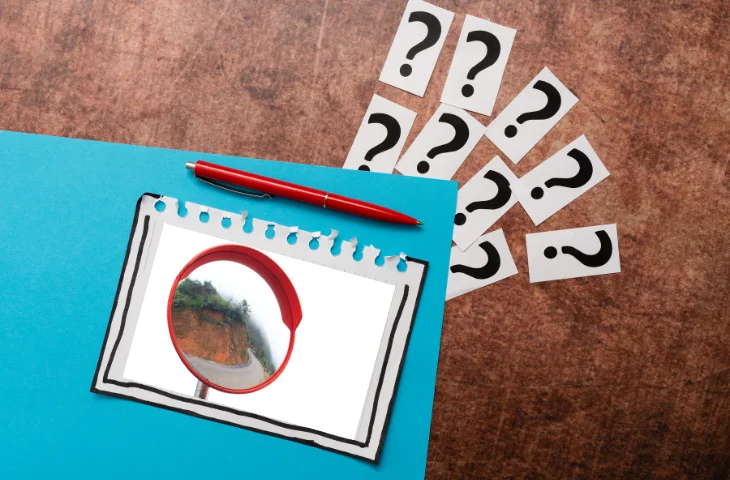Mirror Image is a classic reasoning topic frequently tested in SSC, Banking, and other competitive exams. In this blog, we will provide all the details about what mirror image reasoning means, why it is important in exams, short notes for quick revision, types of questions you can expect, formulas and tricks to solve them efficiently, solved questions from recent 2024–25 exams, and common mistakes to avoid. By the end, you’ll have a clear understanding and handy resources to master this topic quickly.
What Is Mirror Image in Reasoning?
Mirror Image reasoning involves visualizing how an object or figure appears when reflected in a mirror. The task typically requires identifying the correct mirror image (left-right reversed) or deciding if an image matches its mirror reflection.
Why it appears in exams:
Mirror Image tests your visualization skills and attention to detail — abilities crucial in reasoning sections to solve puzzles and spatial problems efficiently.
Skills required:
- Visualization of spatial transformations
- Logical analysis of shapes and patterns
- Mental rotation and symmetry recognition
Why Is Mirror Image Important in Competitive Exams?
Mirror Image questions are popular because they test a candidate’s spatial reasoning and observation skills without requiring complex calculations. These questions often have moderate difficulty, making them a scoring opportunity if prepared well.
| Exam | No. of Questions | Difficulty |
| SSC CGL / CHSL | 1–2 | Easy |
| IBPS PO / SBI PO | 1–2 | Moderate |
| RRB NTPC / Group D | 1 | Easy |
| State PSC / Police | 1–2 | Moderate |
Mirror Image Reasoning Short Notes
Mirror Image reasoning revolves around understanding how images change when reflected:
| Term | Explanation |
| Mirror Line | The line along which reflection takes place. |
| Left-Right Reversal | Objects appear reversed from left to right. |
| Rotation | Sometimes images are rotated before reflection. |
| Inverted Image | Flipped upside down or reversed vertically. |
| No Change | Symmetrical objects remain the same. |
What Are the Types of Mirror Image Questions in Reasoning?
Mirror Image questions generally come in these forms:
- Direct: Identify the mirror image of a given figure.
- Puzzle-based: Mirror images combined with rotations or multiple reflections.
- Coded (symbol-based): Symbols or alphabets presented, and their mirror images tested.
- Mixed-concept reasoning: Mirror images integrated with other reasoning concepts like water images or figure formation.
Mirror Image Formulas for Reasoning
There are no numerical formulas per se, but logical “formulas” help solve these faster:
- Always assume mirror is vertical unless specified.
- Left side of object becomes right side in mirror image.
- Top and bottom remain the same unless mirror is horizontal.
- For rotation + mirror, perform rotation first, then reflect.
- Symmetrical figures remain unchanged; use symmetry as shortcut.
Mirror Image Tricks for SSC CGL and Other Exams
Here are some quick strategies:
- Visualize the mirror line carefully identify whether vertical or horizontal.
- Use tracing paper technique imagine flipping paper along the mirror line.
- Focus on distinctive features small marks or asymmetries help avoid confusion.
- Check left-right reversal first this is the most common error source.
- Draw rough sketches if stuck helps in visual clarity during exam.
- Practice with alphabets and numbers common in IBPS and SBI PO exams.
Solved Mirror Image Questions from 2024–25 Exams
Question 1
Exam: SSC CGL 2024 Tier 1 Shift 2 (Memory-Based)
Question: Identify the mirror image of the given figure when reflected along a vertical line.
Answer: Option C
Explanation: Reverse the left and right sides carefully. The top and bottom remain unchanged.
Question 2
Exam: IBPS PO Prelims 2024
Question: Which figure is the mirror image of the given symbol rotated 90° clockwise?
Answer: Option B
Explanation: Rotate the symbol first, then apply vertical mirror reflection.
Question 3
Exam: RRB NTPC 2025
Question: Choose the mirror image of the alphabet ‘F’ along a vertical mirror line.
Answer: Option D
Explanation: ‘F’ reverses left-right, creating a backward ‘F’.
Common Mistakes to Avoid While Solving Mirror Image Reasoning
When solving mirror image questions, avoid these pitfalls:
- Ignoring mirror line direction — vertical vs horizontal makes a huge difference.
- Forgetting left-right reversal — most common error is confusing the side switch.
- Neglecting rotation order — always rotate first, then reflect.
- Assuming symmetry incorrectly — not all figures are symmetrical; check details.
- Rushing without sketching — a quick sketch often prevents mistakes.
FAQs
Focus on the mirror line orientation, visualize left-right reversal first, and practice regularly to improve speed.
Yes, though fewer in number, mirror image questions often appear combined with other spatial reasoning topics in SBI PO Mains.
It’s not advisable as it is a scoring and easy topic. Skipping may cost you easy marks.
These involve alphabets, numbers, or symbols, testing if you can mentally reverse and rotate them as mirror images.
- RRB NTPC UG CBT 2 Answer Key 2025 Out Today, Check Official Link
- Delhi Police HC Ministerial Syllabus 2025, CBT, Typing & Computer Test
- Delhi Police HC Ministerial Exam Pattern 2025, Check CBT, PE&MT Pattern
- BOI Apprentice Salary 2025, Check Stipend Details
- Upcoming Bank Exams 2026: SBI, IBPS, IBPS RRBs, Insurance Exams
- Bank of India Credit Officer Syllabus 2025, Check Exam Pattern

Hi, I’m Aditi. I work as a Content Writer at Oliveboard, where I have been simplifying exam-related content for the past 4 years. I create clear and easy-to-understand guides for JAIIB, CAIIB, and UGC exams. My work includes breaking down notifications, admit cards, and exam updates, as well as preparing study plans and subject-wise strategies.
My goal is to support working professionals in managing their exam preparation alongside a full-time job and to help them achieve career growth.
